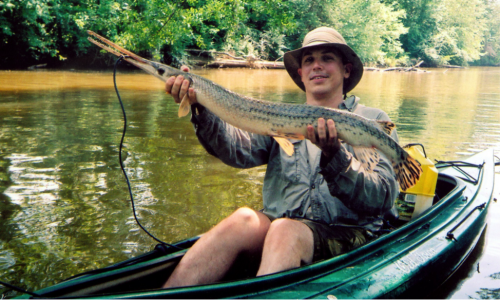Late summer is a great time to fish – for gar!
When other fish won’t bite, try something different and tie on a lure with no hooks.

Late summer can be a bummer for Michigan anglers. The “dog days” heat tends to put bass, pike, and walleye into a slump in many inland lakes. The same heat that drives other fish to sulk in the depths has the opposite effect on another under-appreciated sport fish – the longnose gar.
Hot, calm summer days are perfect for gar fishing for a couple of reasons. First, gar tend to feed most actively on small open-water forage fish like young-of-the year gizzard shad at this time of year. The other reason is a bit surprising. Gar breathe air, and since hot water is low in oxygen gar tend to rise to the surface and gulp air into their swim bladder more frequently during late summer.
Where to look
Longnose gar (not to be confused with alligator gar) often congregate in deep river holes or deep water in inland lakes, but they typically suspend five to ten feet below the surface. If you see one gar surface to gulp air there is a good chance that more are suspended nearby. Longnose gar are most abundant in nutrient-rich inland lakes, large rivers, and Great Lakes waters. The western basin of Lake Erie, Muskegon Lake, the lower Grand River, the Maple River, and inland lakes including Wabasis Lake and Kent Lake are all known for producing Master Angler-sized gar.
No hooks needed
The head and mouth of a longnose gar are extremely bony. There is virtually no place to set a hook, although occasionally a small and extremely sharp treble hook will catch in the side of the mouth. Because of this, gar can easily steal bait intended for other fish. I have gone through dozens of minnows before finally managing to properly set the hook on a gar.
The best way to land a gar involves using nylon rope or twine to tangle in a gar’s teeth. How do you know if your rope will work? Run a comb through it. If the teeth of the comb catch in the unraveled nylon fibers then so will the teeth of a gar.
Once you find a rope that works, the possibilities for lure design are endless. These can be as simple as hookless flies consisting of no more than the rope itself. Rope can also be used to replace the hook of an in-line spinner, the skirt of a spinnerbait, or the bucktail of a jig.
Slow and steady
Even when gar are actively feeding, they are not as explosive or maneuverable as bass or other gamefish. Gar are primitive fish covered with heavy scales that give them a rigid style of swimming. If a lure (or preyfish) passes by quickly or headed in the opposite direction, a gar will typically ignore it.
The best retrieve when fishing for gar is very slow – just turn the crank of the reel fast enough to keep the lure moving. Twitches and quick darting actions with the rod tip may be great for triggering other species, but gar can’t usually keep up with anything too erratic. Instead, pause the retrieve and let the lure free fall slowly for five or ten feet if you can’t trigger a strike with a straight retrieve.
When a gar does take the lure it is important not to jerk the rod in attempts to set the hook. After all, there is no hook to set! Instead, set the drag loose and let the gar run. As the gar swims away and shakes its head the rope will sometimes become more tangled in its teeth. Even this is no sure-fire way to land a gar, though. For every one gar landed, expect that several others will get away.
Why fish for gar, anyway?
Longnose gar are a real challenge to land. Only a handful of anglers have mastered the specialized techniques needed to bring them to the boat with any regularity. On light tackle (think 6-8 pound test) they put up a great fight complete with drag-screeching runs and impressive jumps. The sight of a four-foot gar jumping head-high at boat side is always a thrill!
Michigan Sea Grant helps to foster economic growth and protect Michigan’s coastal, Great Lakes resources through education, research and outreach. A collaborative effort of the University of Michigan and Michigan State University and its MSU Extension, Michigan Sea Grant is part of the NOAA-National Sea Grant network of 33 university-based programs.



 Print
Print Email
Email




